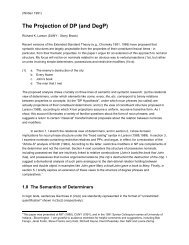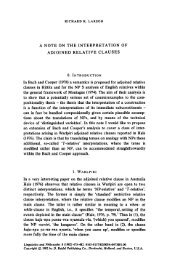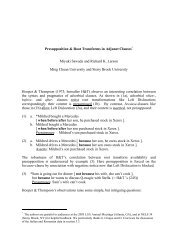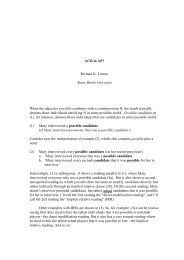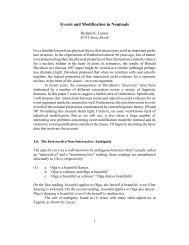Intensional Transitive Verbs and Abstract Clausal Complementation
Intensional Transitive Verbs and Abstract Clausal Complementation
Intensional Transitive Verbs and Abstract Clausal Complementation
You also want an ePaper? Increase the reach of your titles
YUMPU automatically turns print PDFs into web optimized ePapers that Google loves.
<strong>Intensional</strong> <strong>Transitive</strong> <strong>Verbs</strong> <strong>and</strong> <strong>Abstract</strong> <strong>Clausal</strong> <strong>Complementation</strong><br />
acceptability from (29a-c). Again under the Hornstein-Lasnik analysis these must involve raising to raising<br />
to Agr o Spec, <strong>and</strong> under the analysis proposed here, shown schematically in (30d), this is exactly what<br />
occurs.<br />
(30) a. ?Max wants [everyone you do [ VP Ø]] to be elected.<br />
b. ?Max desires [everyone you do [ VP Ø]] to visit Mary.<br />
c. ?Max wishes [everyone you do [ VP Ø]] to be recognized.<br />
d. Max [ AgroP [ DP everyone you [ VP Ø]] V-FOR [ CP t to VP]]<br />
Hence on the Hornstein-Lasnik account, ACD phenomena support the raising analysis. 17,18<br />
2.3 Passive<br />
An important issue that we are obliged to address, one that will become important later, is the analysis of<br />
passive. One of the key reasons for resisting a parallel analysis of ECM <strong>and</strong> for-to constructions is the<br />
well-known asymmetry in (31), which shows that ECM verbs allow passivization of the embedded subject<br />
whereas for-to verbs do not. Given the close analogy our analysis draws between (23a) <strong>and</strong> (25a), we<br />
require an explanation of the contrast:<br />
(31) a. He was believed to be patient.<br />
b. *He was preferred (for) to be patient.<br />
Note further that options are sparse. Since the embedded subject is assumed to raise smoothly to the<br />
Spec of the matrix Agr o in both cases, older ECP-based accounts will not work for us. We must take<br />
movement to be licit in both cases. Furthermore, the ill-formedness cannot be explained by claiming that<br />
the for-to type verbs don’t undergo passive at all. Such verbs can passivize the entire complement clause<br />
(e.g., For Bill to win is fervently desired by Al). If there is to be an explanation of (31a) versus (31b) in our<br />
account, it would seem to have to appeal to some property of the moved item itself: the subject of an ECM<br />
complement versus the subject of a for-to complement. Something about being the subject of a for-to<br />
infinitive must block passive. Our answer to this problem appeals to recent proposals about the Case<br />
marking of infinitival control subjects.<br />
17 The presence of an overt complementizer for strongly blocks ACD in the want-class examples(cf. (ia-c) versus<br />
(30a-c)). Presumably this is due to the fact that, at the relevant level of structure, there will be a Comp-trace violation<br />
comparable to what is seen in the overt example (ii):<br />
(i) a. *Max wants very much for [everyone you do [ VP Ø]] to be elected.<br />
b. *Max desires for [everyone you do [ VP Ø]] to visit Mary.<br />
c. *Max wishes for [everyone you do [ VP Ø]] to be recognized.<br />
(ii) *Max wants [ CP for [ DP everyone you [ VP want [ CP for t to VP ]]] to VP]<br />
18 Kennedy (in press) presents interesting counterarguments to the general claim that movement to Agr can replace<br />
QR in anaccount of quantifier scope. So far as we can tell, however, Kennedy’s point does not undermine Hornstein<br />
<strong>and</strong> Lasnik’s general observation that ACD seems to be licensed primarily in object positions, <strong>and</strong> not simply in<br />
positions from which quantifiers are able to take scope.<br />
11



